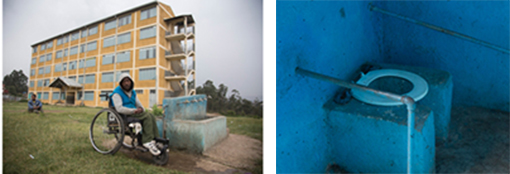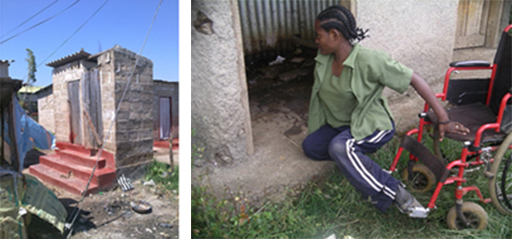8.5 Equity and inclusion in WASH
Like sustainability, equity was introduced to you as one of the advantages of a sector-wide approach. Equity means the fair distribution and sharing of resources (natural or manmade) to benefit everyone equally. The OWNP includes mention of gender equity, which it links to gender mainstreaming and the need to ensure women are included in WASH schemes (OWNP, 2013). Equity also applies to other marginalised and disadvantaged sections of society. If someone is marginalised it means they are treated as insignificant or not important, or literally, pushed to the edges, or margins. Marginalised groups include people with disabilities of many different types, older people, children and people living with long-term illnesses including HIV/AIDS. It can also include residents of geographically hard-to-reach areas, internally displaced people, informal settlers and slum dwellers. All these vulnerable groups, for different reasons, may face barriers that restrict their access to WASH services (Figure 8.5).

The term equity is frequently linked with inclusion. Inclusion means the process of including these marginalised and unserved communities within, and not separate from, society as a whole. For WASH, it means considering their needs at all stages of WASH programmes, from planning to evaluation. Equity and inclusion are important cross-cutting issues in WASH because these groups of people have frequently been neglected in the past.

Look at Figure 8.6. Is the design of this facility helpful for Eniyew? How does the design of the cubicle make it easier for him to use? Will he have problems when he tries to wash his hands?
This design is quite helpful for him because the taps are low down, though he may have some difficulty in reaching them. It is good that the concrete surround is flat without any steps that would prevent him wheeling his chair right up to the taps. The cubicle has a raised seat and handrails which should help him transfer from his wheelchair.
Many of the WASH policies and programme documents that you have read about in previous study sessions include statements about the importance of access to water and sanitation for all. For example, the introduction of the WIF explicitly states: ‘This document is introducing WASH for all, which also includes disabled, disadvantaged and low-income communities’ (WIF, 2011). The main OWNP document says that the Programme ‘will promote and support social inclusion as an important strategy to enhance equity and reduce disparities in access to WASH services’ and describes ‘social inclusion’ as including ‘gender equity and mainstreaming, resettlement areas and areas with high concentrations of ethnic minorities and pastoralists and institutional WASH facilities that do not restrict access to handicapped and disabled persons’ (OWNP, 2013).
The challenge for the OWNP and its implementation is ensuring that this goal of ‘including all’ is properly integrated into plans and schemes and that all the diverse needs of the different groups of marginalised and vulnerable people are considered. For example, among disabled people, the needs of wheelchair users like Eniyew are not the same as people with other problems (Figure 8.7). Older people and others who need support rails to hold onto, people with poor sight, and disabled children are just a few of these groups with very specific needs. It is important that stakeholders with responsibility for planning and implementation recognise these varying needs and ensure that individual groups are not overlooked.

Look at Figure 8.7. How could these latrines be improved to make them more accessible to people with disabilities?
In Figure 8.7(a), the steep steps would be difficult for disabled people but could be improved if there was a handrail to hold onto. In Figure 8.7(b) the young woman has to leave her wheelchair outside the latrine cubicle and drag herself across the dirty floor. It could be improved if it was big enough for her to wheel her chair inside and had a raised seat with hand rails, similar to the one in Figure 8.6 (b). It would also be improved if the floor was kept clean.
You have already come across the idea of accountability in the OWNP. The revised Memorandum of Understanding of 2012 specified that the four WASH ministries should be accountable for their actions to each other and to others (see Study Session 3). In the vertical relationships within any organisation, people are accountable upwards to their managers and downwards to the levels below them in the hierarchy.
Social accountability in WASH is a concept that deals with the accountability of the service providers (government, development partners, CSOs, private sector, etc.) to the user communities. It means that community members, who are the primary beneficiaries, can ask questions and claim their right to a full account of the service(s) provided.
Social accountability means that the users have the opportunity to access all the information about projects implemented for their benefit. This information could include the source of funding, cost of the project, duration, design, effects on the livelihood of community members, effects on plants and animals, and the roles and responsibilities of the beneficiaries during and after project implementation. If appropriate mechanisms are in place, social accountability allows community members to obtain all the important information regarding the projects in order to enable them to assess the service provider’s performance.
8.4 Sustainability in WASH
